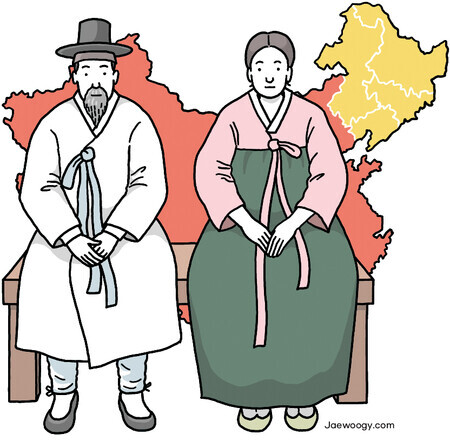hankyoreh
Links to other country sites 다른 나라 사이트 링크
[Column] The hanbok belongs to the Korean diaspora, too

South Koreans were in an uproar after a woman appeared at the Beijing Winter Olympics opening ceremony dressed in a traditional Korean hanbok outfit.
If we simply consider the fact that hanbok is traditional Korean clothing, the comments by internet users about a “hanbok project” along the same lines as China’s Northeast Project may just seem like satire. But the moment we consider the additional variable — the fact that the woman in question was Korean Chinese — things become a bit more complex.
In the procession, people representing China’s 55 minority ethnicities each wore their own traditional garments. What exactly was this Korean Chinese participant supposed to wear?
That question forces us in turn to confront another matter — namely, who are China’s ethnic Koreans?
“Joseonjok,” the word that Koreans use for ethnic Koreans in China, is not an official term. It’s more of a slang or derogatory term, similar to the ways in which Korean Chinese characters are often depicted in movies as criminals threatening security and livelihoods. The legal term is “Hangukgye Junggugin,” which simply means “Chinese of Korean descent.”
In China, “Chaoxianzu” — the word literally corresponding to “Joseonjok” — actually is an official term. Through this term, individuals who share an identity as people with Korean ethnicity become citizens under the Chinese system. It’s an identity granted by China’s constitution.
According to the constitution, the Regional National Autonomy Law, and the Yanbian Korean Autonomous Prefecture Ordinance, individuals are guaranteed the official use of the Chaoxianzu language and writing system within autonomous regions of Yanbian Korean Autonomous Prefecture. The Chaoxianzu language and writing system are, of course, Korean and Hangul, respectively.
The historical roots of the Chaoxianzu people lie in Goguryeo and Balhae. The “Chaoxianzu” concept is quite a modern invention.
In the 1860s, large numbers of Koreans migrated to Manchuria amid natural disasters and poor harvests in the northern part of the Korean Peninsula. This was the starting point for the ethnic community that formed around the Yanbian region.
During Japanese occupation, there were four additional major migrations, which coincided with major political upheavals in Northeast Asia. After Japan’s defeat in 1945 and the division of the Korean Peninsula, there was another spell of turbulence, with some returning to South and North Korea and others staying behind in China. The “Chaoxianzu” title became official with the establishment of the People’s Republic of China.
The migrants were quite a diverse group. Some were independence activists; others were just trying to subsist. Figures like the poet Yun Dong-ju, the author Song Mong-gyu, and the pastor/activist Moon Ik-hwan were not Chaoxianzu, but their friends who remained in Longjing were.
This year marks the 70th anniversary of the Yanbian Korean Autonomous Prefecture’s establishment. Communities have been rapidly disintegrating since China’s adoption of policies of openness, and there’s been a boom in travel to South Korea since it established diplomatic relations with China.
As of Sept. 30, 2021, “Chinese of Korean descent” represented the single largest group of registered foreign nationals in the South, accounting for 256,030 out of 1,091,369, or 23.5%. Their diaspora has been taking place over a period of 160 years — and it is still ongoing.
The hanbok isn’t just ours, but theirs as well.
By Ahn Yeong-chun, editorial writer
Please direct questions or comments to [english@hani.co.kr]

Editorial・opinion
![[Column] Park Geun-hye déjà vu in Yoon Suk-yeol [Column] Park Geun-hye déjà vu in Yoon Suk-yeol](https://flexible.img.hani.co.kr/flexible/normal/500/300/imgdb/original/2024/0424/651713945113788.jpg) [Column] Park Geun-hye déjà vu in Yoon Suk-yeol
[Column] Park Geun-hye déjà vu in Yoon Suk-yeol![[Editorial] New weight of N. Korea’s nuclear threats makes dialogue all the more urgent [Editorial] New weight of N. Korea’s nuclear threats makes dialogue all the more urgent](https://flexible.img.hani.co.kr/flexible/normal/500/300/imgdb/original/2024/0424/7317139454662664.jpg) [Editorial] New weight of N. Korea’s nuclear threats makes dialogue all the more urgent
[Editorial] New weight of N. Korea’s nuclear threats makes dialogue all the more urgent- [Guest essay] The real reason Korea’s new right wants to dub Rhee a founding father
- [Column] ‘Choson’: Is it time we start referring to N. Korea in its own terms?
- [Editorial] Japan’s rewriting of history with Korea has gone too far
- [Column] The president’s questionable capacity for dialogue
- [Column] Are chaebol firms just pizza pies for families to divvy up as they please?
- [Column] Has Korea, too, crossed the Rubicon on China?
- [Correspondent’s column] In Japan’s alliance with US, echoes of its past alliances with UK
- [Editorial] Does Yoon think the Korean public is wrong?
Most viewed articles
- 1‘We must say no’: Seoul defense chief on Korean, USFK involvement in hypothetical Taiwan crisis
- 2Will NewJeans end up collateral damage in internal feud at K-pop juggernaut Hybe?
- 3[Column] Park Geun-hye déjà vu in Yoon Suk-yeol
- 4Why Korea shouldn’t welcome Japan’s newly beefed up defense cooperation with US
- 5Thursday to mark start of resignations by senior doctors amid standoff with government
- 6N. Korean hackers breached 10 defense contractors in South for months, police say
- 7[Guest essay] The real reason Korea’s new right wants to dub Rhee a founding father
- 8[Column] ‘Choson’: Is it time we start referring to N. Korea in its own terms?
- 9Kim Jong-un expressed ‘satisfaction’ with nuclear counterstrike drill directed at South
- 10[Editorial] New weight of N. Korea’s nuclear threats makes dialogue all the more urgent